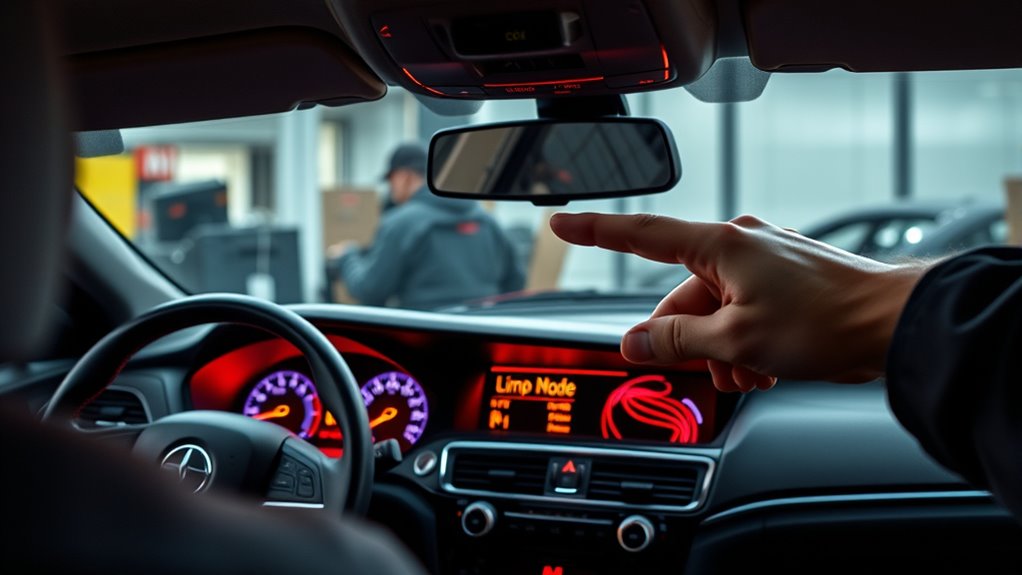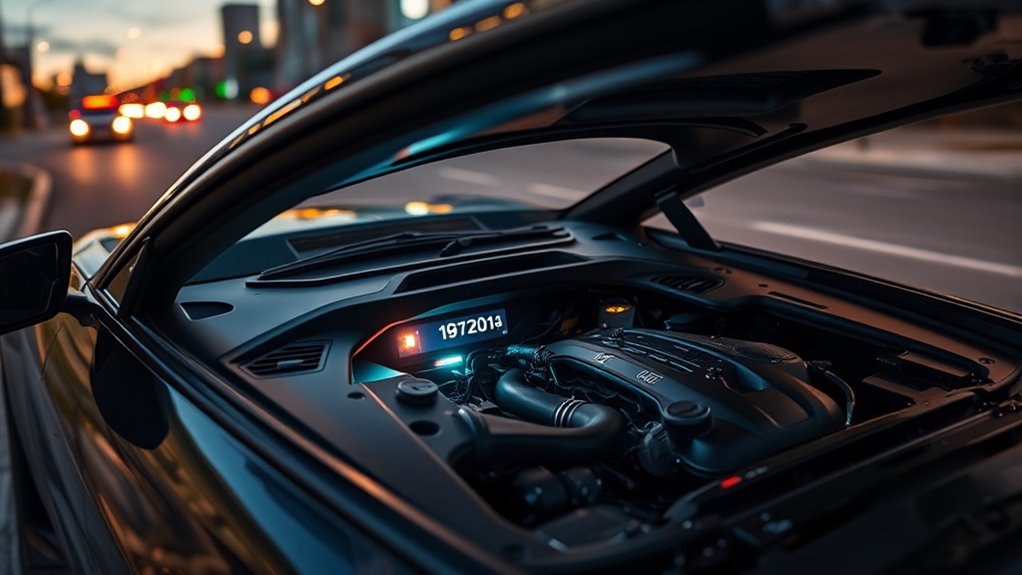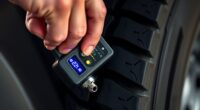Limp mode is a safety feature that activates when your vehicle detects serious issues with the engine or transmission, so it limits power and reduces speed to prevent damage. Common triggers include faulty sensors, transmission problems, or minor issues like a loose gas cap. While your car remains drivable, it’s less responsive. To recover safely, get diagnostics to identify the root cause. Keep going to find out how you can protect and maintain your vehicle’s health.
Key Takeaways
- Limp mode is a safety feature activated when the vehicle’s computer detects critical issues, limiting performance to prevent damage.
- Common triggers include faulty sensors, transmission problems, or electronic control unit errors.
- When in limp mode, the vehicle remains drivable but with reduced power and responsiveness.
- Recognizing warning signs like a check engine light or sluggish response aids in early detection.
- Safe recovery involves diagnostic testing to identify the root cause and professional repairs, avoiding further damage.

Limp mode is a safety feature built into your vehicle’s computer system that activates when it detects a problem that could damage the engine or transmission. Its primary purpose is to protect critical components by limiting the vehicle’s power, speed, and overall performance. When this mode kicks in, you might notice a sudden drop in acceleration, the check engine light turning on, or the vehicle feeling sluggish and unresponsive. You may also see warning messages on your dashboard, alerting you to issues that need immediate attention. Recognizing these signs early can help you avoid further damage and costly repairs.
Limp mode activates to protect your engine when a serious issue is detected.
Limp mode is triggered by a variety of issues, ranging from minor sensor glitches to more serious mechanical problems. Common causes include faulty mass airflow sensors, worn-out throttle bodies, transmission malfunctions, or issues with the vehicle’s electronic control unit (ECU). Sometimes, simple problems like a loose gas cap or dirty air filter can cause the system to activate limp mode.
When the ECU detects irregularities in critical signals or data, it automatically switches your vehicle into limp mode to prevent potential damage. Think of it as your car’s way of safeguarding itself until you can get professional help.
Once limp mode is engaged, your vehicle might feel considerably less powerful, but it remains drivable. This is intentional, allowing you to get to a safe location or a repair shop without risking further harm. However, you should avoid aggressive driving, high speeds, or sudden acceleration, as these actions can worsen underlying issues.
If you notice limp mode, it’s essential to address the root cause promptly. The first step is to check for any warning lights or error codes, which can be retrieved with an OBD-II scanner. Many auto parts stores offer free diagnostic tests, or you can visit a mechanic for a thorough diagnosis.
Recovering from limp mode involves fixing the underlying problem that triggered it. Sometimes, resetting the ECU by disconnecting the battery for a few minutes can temporarily clear the fault, but this doesn’t resolve the root issue. If the problem persists, you’ll need professional diagnostics to identify and repair the faulty component.
Driving with limp mode active for extended periods or ignoring warning signs can lead to further damage, increased repair costs, or safety risks. Additionally, understanding vehicle safety features like limp mode can help you better respond to car issues and maintain your vehicle’s health and safety on the road.
Frequently Asked Questions
Can I Drive My Car Long Distances in Limp Mode?
You shouldn’t drive your car long distances in limp mode. It’s a protective feature that limits engine power to prevent damage, but it also indicates a serious issue.
Continuing to drive can worsen the problem and lead to costly repairs. If your car enters limp mode, pull over safely, turn off the engine, and get it inspected by a mechanic promptly.
Avoid risking further damage by driving it extensively in this state.
How Much Does It Cost to Repair Limp Mode Issues?
Fixing limp mode issues can feel like chasing a moving target, but costs vary widely. Typically, repairs range from $150 to $1,000 or more, depending on the underlying problem.
You might spend less on simple sensor replacements or more if you need significant engine repairs. To avoid surprises, get a diagnostic scan first. This way, you’ll know exactly what’s wrong and can plan your budget accordingly.
Is Limp Mode the Same Across All Vehicle Brands?
No, limp mode isn’t the same across all vehicle brands. While the purpose—to protect your engine—is consistent, the triggers and how it’s activated can vary.
Some brands may have more sensitive sensors, causing limp mode to engage sooner, while others might have different diagnostic systems.
It’s crucial to check your vehicle’s manual or consult a mechanic familiar with your specific make to understand how limp mode functions in your car.
Will Ignoring Limp Mode Cause Engine Damage?
Ignoring limp mode can lead to engine damage, much like neglecting warning lights on your dashboard. While it might seem safe to keep driving, you’re risking serious issues, such as overheating or component failure.
Limp mode is your vehicle’s way of protecting itself. If you dismiss it, you could cause costly repairs.
It’s smarter to address the problem promptly, ensuring your engine stays healthy and reliable in the long run.
How Can I Reset Limp Mode Myself?
To reset limp mode yourself, start by turning off your vehicle and waiting a few minutes to allow the system to reset.
Check for any obvious issues like loose connections or damaged sensors, then reconnect or replace as needed.
You can also try disconnecting the battery for about 10-15 minutes to clear the error codes.
However, if the problem persists, it’s best to have a mechanic diagnose and fix the underlying cause.
Conclusion
Now that you understand what triggers limp mode and how to recover from it, you’ll be better prepared to handle this sudden shutdown. Think about your car as a trusted ally that steps in to protect you when things go wrong. Isn’t it reassuring to know that, with the right knowledge, you can navigate these moments safely and get back on the road? Remember, staying calm and informed keeps you in control, no matter what your vehicle throws your way.









